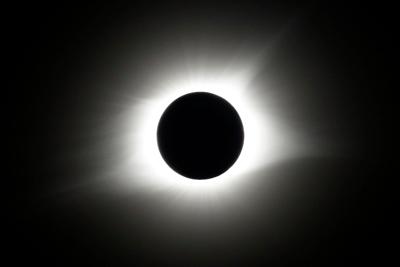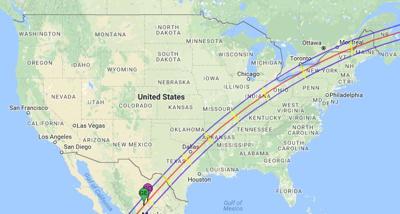A once-in-a-lifetime celestial phenomenon will grace the skies of central New York this spring when a total solar eclipse is visible the afternoon of Monday, April 8.
Cayuga County is already preparing for the spectacle, which is anticipated to bring an influx of sky gazers — technically known as "umbraphiles," or shadow lovers — to the region.
They travel far, even internationally, to witness total solar eclipses, the Cayuga County Office of Tourism's Claire Dunlap told Ë®ąűĹÉAV. According to , a given point on Earth only sees totality — the moon's shadow fully covering the sun — every 400 to 500 years, on average. The last time an eclipse's path of totality touched Cayuga County was 1925, and the next time will be 2144.
To demonstrate the impact the rare event has on an area, Dunlap referred to held in Columbia, South Carolina, which saw a total solar eclipse in 2017. Hotels were 95% to 100% occupied in the days prior, increases of 40% to 60%. Breweries and restaurants were "slammed," doing more than 20% more business. Retail and museum gift shop sales tripled.
People are also reading…
That's why the county tourism office is getting a jumpstart, Dunlap said, on the spring event. Plans include a commemorative poster, as well as participation in regional and state marketing efforts.
Traffic is another focus. Delays are anticipated, particularly around the village of Fair Haven. As the northernmost point of Cayuga County, it will be closest to the path of totality.
Fair Haven Beach State Park will be opening earlier than usual that morning for the event, Dunlap said. But due to the limited number of roads in the area, the tourism office suggests implementing safety plans for emergency vehicles. The office also noted that several New York school districts have already canceled classes that day due to the traffic concerns.
The eclipse will last around 45 minutes, the office said, but Fair Haven will see about three minutes and 23 seconds of totality. That's followed by 2:30 in Cayuga, 2:05 in Weedsport, 1:09 in Union Springs and 1:04 in Auburn. The view is subject to location and weather, but the more northern and rural areas of Cayuga County will generally offer the best, Dunlap said.

The next total solar eclipse to sweep across the U.S. will be visible from Texas to Maine in 2024.
Alan Ominsky, the former director of the Southern Cayuga Planetarium, moved to the area from Minnesota in the early 2000s. He expressed his excitement about the eclipse, with a chuckle.
"We have an observatory here," he told Ë®ąűĹÉAV, "but there aren't many clear nights."
Ominsky said the eclipse will be something to see, though viewers should not directly look at it. Pinhole projectors are commonly built with paper plates, but those who want to witness the spectacle firsthand can use branded filtered glasses being released by the county tourism office. They're now available, Dunlap said, and provide safe viewing of the totality.Â
Ominsky said binoculars and telescopes can be used as well, but their lenses will need special filters for proper viewing.
"These (filters) will darken the light and only a small portion of the sun's light will enter your eye," he said. What viewers will see are sunspots and the sun's corona, the outermost part of its atmosphere. "People may not realize the the sun's rotating," he continued, explaining that flicks of hydrogen will be seen as little white spicules around the moon.
Though the next total solar eclipse might not come to Cayuga County for more than a century, the spectacle is somewhat common, Ominsky said.
"Total eclipses occur some eight to 10 years somewhere on Earth," he said. "It's just being in the right place at the right time."
Ominsky briefly reflected on an eclipse he witnessed in the 1950s at the University of Minnesota. It was a big deal, and NBC and CBS hosted live feeds as it took place.
"I was lucky it happened," he said. "It's one of the most magical sights in the sky."
Staff writer Christopher Malone can be reached at (315) 282-2232 or christopher.malone@lee.net.


















